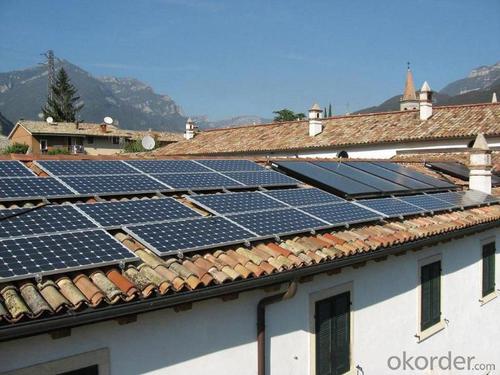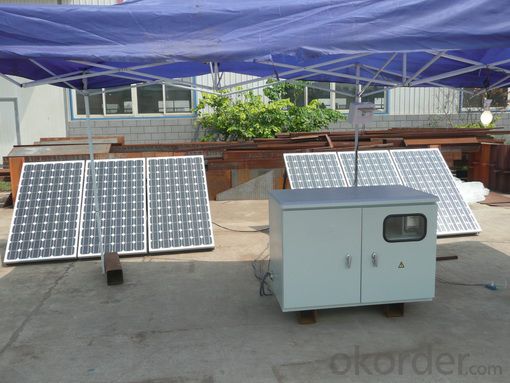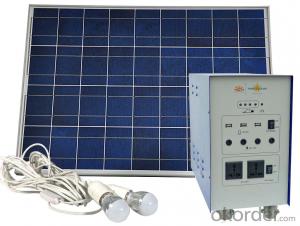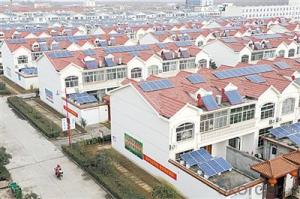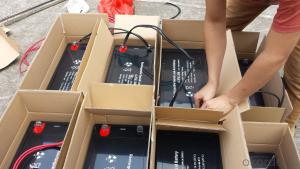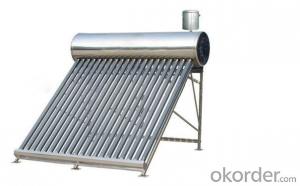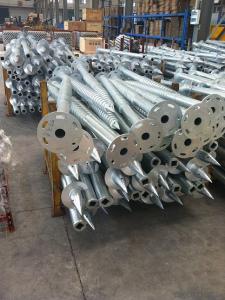PV Solar Energy Systems - Roof Solar Power System Hot Sale 2024 New
- Loading Port:
- Shanghai
- Payment Terms:
- TT or LC
- Min Order Qty:
- 500 watt
- Supply Capability:
- 2000000 watt/month
OKorder Service Pledge
OKorder Financial Service
You Might Also Like
Quick Details
| Quick Details | |||||
| Specification: | Normal | Application: | Home | Output Voltage (V): | AC110V/220V |
| Load Power (W): | 3KW | Solar Power (W): | 3KW | Work Time (h): | 48 |
| Cables: | 50m | Solar Panel Rack: | Optional | Battery Capacity: | 12V/200AH*8pcs |
| Controller Voltage: | 48V | Inverter Output Voltage: | AC220V/110V | Efficiency: | 90% |
| Inverter: | DC48V | Rated Output Capacity: | 3000W | Solar Panel Power: | 250w*12pcs |
| Solar Panel Type: | Crystalline Silicon PV Module | ||||
Packaging & Delivery
| Packaging & Delivery | |
| Packaging Detail: | using carton or wooden box as per customer's requirement. |
| Delivery Detail: | within 10~30 days for shipment depending on order quantity |
Excellent battery backup 300W to 10KW off grid solar system with grid power switch
Anern Advantage:
1) Over 10 year experience in clean energy line, business covering solar street light, solar garden light, off grid
solar system and on grid solar power system, etc;
2) Exporting for worldwide, with satisfied clients more than 50 countries;
3) Competitive price, excellent service, integrated certificate system;
We supply CE, RoHS certificates if you need
Welcome to visit our factory at any time.
Solar system advantages:
1. CE, ROHS approved.
2. High conversion efficiency, high-transmission rate.
3. Energy saving, environmental-friendly.
4. Advanced technology, strict quality control system.
5. Easy installation, safe operation, free maintenance.
6. Low MOQ, fast delivery time, long service life
Specifications:
| Ref No. | OFF-SGHP-3KW | |
| System Basic Information | Solar Panel Rated Output Power | 3KW |
| Suitable for Max Daily Power Consumption | 10KWH | |
| Rated Output AC Capacity | 3KW | |
| Solar panel | ||
| Type | Crystalline Silicon PV Module, A-class | 12pcs |
| Max Power | 250W | |
| Vmp | 30.5V | |
| Size | 1655*992*45mm | |
| Weight | 22.5kg/pc | |
| 25 years power output guarantee (Note: 2pcs panels connect in series) | ||
| Controller | ||
| Voltage | 48V | 1pc |
| Current | 60A | |
| Warranty | 1 year | |
| PWM high-efficiency charging controller, LED display, intelligent control; Temperature compensation, various protections. | ||
| Circuit Breaker | Used for protection of controller, installed between PV array combiner and controller | 1pc |
| Inverter | ||
| Input Voltage | DC48V | 1set |
| Output Voltage | AC220V/110V 1-phase | |
| Frequency | 50/60Hz | |
| Efficiency | 90% | |
| Note: This inverter provides grid power switch and battery charging functions. | ||
| Battery | ||
| Capacities | 12V/200AH per piece | 8pcs |
| Service life | 5 to 6 years | |
| Warranty | 3 years | |
| Solar panel rack | Flat-roof type mounting rack, steel material, anti-rust treatment | 1 set |
| (Other types of racks can be customized as per client's requirement) | ||
| Cable | 50m | |
| Connectors | 3-terminal connectors, used for panels connection in parallel | 6 set |
Product features:
1. Off grid solar power system is mainly used for application with relatively-small power consumption, and the areas have no grid network coverage, or grid power is unstable or outage condition.
2. It’s composed of solar panels, hybrid solar inverter, battery bank, solar panel mounting racks, and other accessories required fora complete home solar power system.
3. The battery bank gives a stable power output to the solar inverter which converts DC to AC to power loads, and provides power backup in rainy or cloudy days.
4. The solar panels generate electricity at daytime and charge the battery bank .
5. The off grid home solar power system provides grid power bypass in case of battery power shortage when sunshine is not enough.
6. All the off grid home solar power system configurations are worked out by scientific calculation and design.
FAQ
We have organized several common questions for our clients,may help you sincerely:
①what price for each watt?
it depends on the quantity, delivery date and payment terms,
②what is your size for each module? can you tell me the parameter of your module?
we have different series of panels in different output, both c-si and a-si. please take the specification sheet for your reference.
③Can you provide the peripheral products of the solar panels, such as the battery, controller, and inverter? If so, can you tell me how do they match each other?
Yes, we can, we have two companies for solar region, one is CNBM International, the other is CNBM engineering Co.
We can provide you not only the solar module but also Solar Cells, the off grid solar system, we can also provide you service with on grid plant.
④What is your warranty system?
Our product performance guarantees for 25 years
• 12 years guarantee for workmanship
• Timeliness of delivery
• Quality Products certified (TÜV, UL, CE, ISO)
⑤How do you pack your products?
We have rich experience on how to pack the panels to make sure the safety on shipment when it arrives at the destination.
⑥ Can you do OEM for us?
Yes, we can.
⑦How long can we receive the product after purchase?
In the purchase of product within three working days, We will arrange the factory delivery as soon as possible. The pecific time of receiving is related to the state and position of customers. Commonly 7 to 10 working days can be served.
- Q: What is the role of solar trackers in solar energy systems?
- The role of solar trackers in solar energy systems is to optimize the efficiency and output of solar panels by tracking the movement of the sun throughout the day. Solar trackers automatically adjust the position of the panels to ensure that they are always facing the sun at the optimal angle, maximizing the absorption of sunlight and increasing the overall energy generation of the system.
- Q: Can solar energy systems be financed or leased?
- Yes, solar energy systems can be financed or leased. Many companies and financial institutions offer financing options to make solar energy systems more affordable for homeowners and businesses. Leasing is another popular option where the solar panels are owned and maintained by a third-party company, allowing customers to benefit from the energy generated without the upfront costs of purchasing the system.
- Q: How do solar energy systems affect the reliability of the electrical grid?
- Solar energy systems can have both positive and negative effects on the reliability of the electrical grid. On the positive side, solar energy systems can help diversify the energy sources used for electricity generation, reducing dependence on traditional fossil fuels. This diversification can enhance the overall stability and reliability of the electrical grid. Furthermore, solar energy systems can contribute to reducing peak demand on the grid. During daylight hours, when solar panels are most productive, they generate electricity that can be directly utilized by nearby buildings or fed back into the grid. This can help alleviate stress on the grid during periods of high demand, reducing the likelihood of power outages or blackouts. However, solar energy systems also present some challenges to grid reliability. One of the key concerns is the intermittent nature of solar power generation. Solar panels only produce electricity when the sun is shining, meaning that their output is subject to variations due to weather conditions and the time of day. This intermittency can make it challenging to match supply with demand, especially during cloudy or nighttime hours, leading to potential imbalances or fluctuations in the grid. To address this issue, grid operators need to carefully manage the integration of solar energy systems into the electrical grid. This involves implementing advanced forecasting and monitoring technologies to accurately predict solar power generation and plan for any potential fluctuations. Additionally, energy storage systems, such as batteries, can be deployed to store excess solar energy during periods of high generation and release it during times of low generation, helping to smooth out the intermittent nature of solar power. Overall, while solar energy systems bring many benefits to the electrical grid, such as diversification of energy sources and reducing peak demand, they also pose challenges related to intermittency. By adopting advanced technologies and implementing effective grid management strategies, these challenges can be mitigated, ensuring a reliable and resilient electrical grid.
- Q: Can solar energy systems be used for heating and cooling buildings?
- Yes, solar energy systems can indeed be used for heating and cooling buildings. Solar energy systems, such as solar thermal systems and photovoltaic (PV) systems, can be utilized to provide both heating and cooling solutions for buildings. Solar thermal systems capture the heat from the sun and convert it into usable thermal energy. This energy can then be used for space heating, water heating, and even for cooling purposes. In a solar thermal heating system, solar collectors are installed on the roof or façade of a building to capture the sun's heat. This heat is then transferred to a heat exchanger or a heat storage system, which can be used to heat the building during colder periods. Similarly, solar thermal cooling systems use the sun's heat to power absorption chillers or desiccant cooling systems. These systems use the heat energy to drive a refrigeration cycle, which can cool the air inside a building. Solar thermal cooling systems are particularly effective in hot climates where cooling demands are high, as they can reduce the reliance on traditional air conditioning systems. Furthermore, PV systems can also contribute to the heating and cooling of buildings indirectly. By generating electricity from sunlight, PV systems can power electric heating or cooling devices, such as heat pumps and air conditioners. While PV systems are primarily known for their ability to generate electricity, this electricity can be used to operate heating and cooling systems, thereby reducing the need for fossil fuel-based heating or cooling methods. In conclusion, solar energy systems can be utilized for both heating and cooling purposes in buildings. Whether through solar thermal systems directly capturing the sun's heat or through PV systems indirectly powering heating and cooling devices, solar energy can provide sustainable and environmentally friendly solutions for heating and cooling buildings.
- Q: Can solar energy systems be used in powering traffic signals?
- Yes, solar energy systems can be effectively used to power traffic signals. Solar panels can be installed on top of the traffic signal poles to generate electricity from sunlight, which can then be stored in batteries for nighttime or cloudy weather use. This renewable energy source reduces dependence on the electrical grid and lowers operational costs, making it an eco-friendly and cost-effective solution for powering traffic signals.
- Q: Are there any regulations or permits required for installing solar energy systems?
- Yes, there are regulations and permits required for installing solar energy systems. The specific requirements vary depending on the location and jurisdiction, as regulations are set at the local, state, and national levels. These regulations and permits are put in place to ensure that the installation of solar energy systems is safe, compliant with building codes, and meets local zoning requirements. Typically, a building permit is required to install a solar energy system. This permit ensures that the installation is done correctly and follows all necessary safety guidelines. The permit process usually involves submitting detailed plans and documentation, including structural engineering reports and electrical diagrams. These documents are reviewed by the local building department to ensure compliance with applicable codes and regulations. In addition to building permits, there may be other permits or approvals required for solar energy systems. This could include electrical permits, zoning permits, or even historic preservation approvals in certain areas. It is important to consult with the relevant authorities and obtain all necessary permits before installing a solar energy system to avoid any legal or safety issues. Furthermore, some jurisdictions may have specific regulations regarding the size, placement, and design of solar energy systems. These regulations are typically aimed at preserving the aesthetics of the area and ensuring the systems do not pose any risks or nuisances to neighboring properties. It is worth noting that regulations and permit requirements are constantly evolving and can vary greatly from one jurisdiction to another. Therefore, it is advisable to consult with local authorities or hire a professional solar energy installer who is familiar with the local regulations to ensure compliance throughout the installation process.
- Q: Can solar energy systems be used in camping or outdoor activities?
- Yes, solar energy systems can be used in camping or outdoor activities. Portable solar panels, solar-powered lanterns, and solar chargers for electronic devices are some examples of solar energy systems that are designed for outdoor use. These systems harness the power of the sun to provide renewable energy, making them an eco-friendly and convenient solution for powering equipment and devices during camping or other outdoor activities.
- Q: What is the role of charge controllers in solar energy systems?
- The role of charge controllers in solar energy systems is to regulate and control the flow of electricity between the solar panels and the batteries. They ensure that the batteries are charged efficiently and prevent overcharging or damage to the batteries. Additionally, charge controllers help optimize the performance and lifespan of the batteries by providing protection against over-discharging and excessive voltage.
- Q: Can solar energy systems be used for powering remote sensing devices?
- Solar energy systems are definitely capable of powering remote sensing devices. They serve as an exceptional energy source for areas with limited or no access to traditional power grids. Remote sensing devices, like weather stations, surveillance cameras, tracking systems, or environmental monitoring instruments, necessitate a consistent and dependable power supply to function effectively. Solar energy systems, such as solar panels or photovoltaic (PV) cells, have the ability to directly convert sunlight into electricity. These systems can be set up in remote regions to harness solar energy and offer a sustainable and renewable power source for remote sensing devices. Solar panels are typically constructed using semiconductor materials that absorb sunlight and generate direct current (DC) electricity. This electricity can be used immediately to power the sensing devices or stored in batteries for later use during periods of low sunlight or at night. Utilizing solar energy systems to power remote sensing devices presents numerous advantages. Firstly, solar power is readily available and abundant in most parts of the world, making it highly suitable for remote locations where other power sources may not be feasible. Secondly, solar energy is clean and renewable, thus reducing reliance on fossil fuels and minimizing environmental impact. Additionally, solar power systems require minimal maintenance and possess a long lifespan, making them cost-effective and reliable for powering remote sensing devices. In conclusion, solar energy systems offer a practical and sustainable solution for powering remote sensing devices. They provide a reliable and renewable energy source, enabling remote sensing devices to operate efficiently in remote and off-grid locations.
- Q: Can solar energy systems be used for powering off-grid eco-lodges?
- Yes, solar energy systems can definitely be used for powering off-grid eco-lodges. Solar panels can be installed on the roofs of these lodges to capture sunlight and convert it into electricity. This renewable energy source can then power various electrical appliances, lighting, heating, and cooling systems within the lodges. By harnessing solar power, off-grid eco-lodges can operate sustainably and reduce their reliance on traditional grid electricity, leading to a more environmentally friendly and self-sufficient operation.
Send your message to us
PV Solar Energy Systems - Roof Solar Power System Hot Sale 2024 New
- Loading Port:
- Shanghai
- Payment Terms:
- TT or LC
- Min Order Qty:
- 500 watt
- Supply Capability:
- 2000000 watt/month
OKorder Service Pledge
OKorder Financial Service
Similar products
Hot products
Hot Searches
Related keywords



